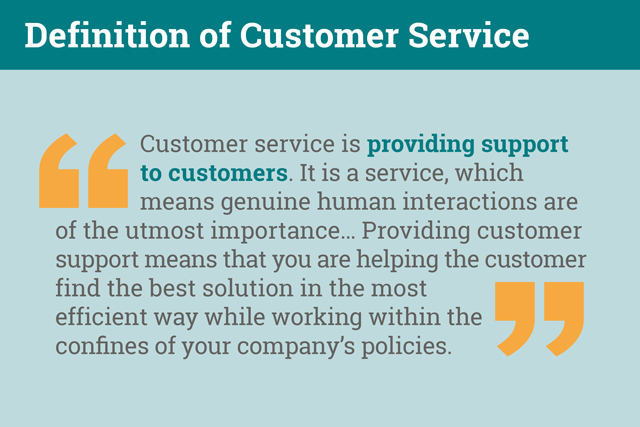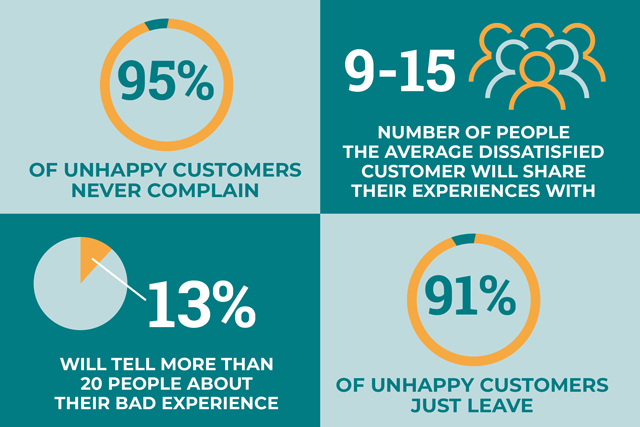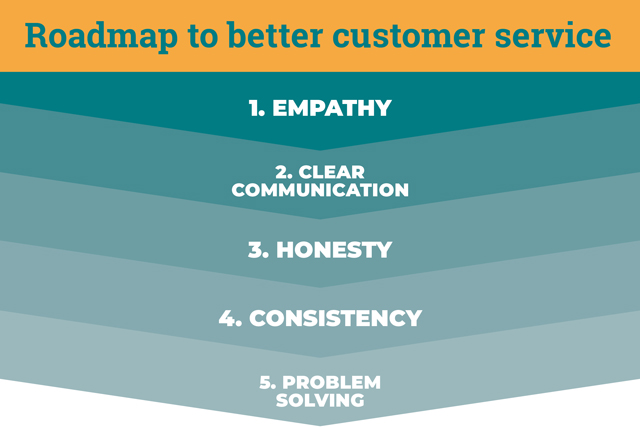
Customer service is the backbone of any company. If you cannot provide quality service to your customers, you won’t have them for very long. Too often, good customer service is overlooked in favor of marketing and sales. But investing time into developing customer service skills is the best way to protect your bottom line and maintain a loyal, happy customer base.
Think of your customer service team as the front lines of defense. If a potential customer has a question, a service representative has the power to turn them into a paying client. When a customer has a problem, the way a service rep handles it can either lose an existing customer or keep them around for a long time.
With a strong customer service team, you can eliminate many issues before they become dealbreakers. It’s important to hire people with a good foundation of customer service skills, and it’s crucial to develop these through your training period and ongoing support.
Before we get into these mysterious, almost mythical, customer service skills, let’s go back to basics.

What Is Customer Service and Why Does It Matter?
Everyone knows what customer service is, right? Well, sometimes we lose sight of the most basic definition, and that leads to confusion and inconsistency within a company.
Customer service is providing support to customers. It is a service, which means genuine human interactions are of the utmost importance. Support does not mean that the customer gets exactly what they want, regardless of company policy. Support does not mean that you have to become the client’s therapist, nor does it mean that you deserve to be verbally abused.
Providing customer support means that you are helping the customer find the best solution in the most efficient way while working within the confines of your company’s policies.
Now that we’ve covered the basic definition of customer service, let’s talk about how you can further define it for your team. There are many philosophies of customer service out there, but they all come down to defining values that work within the mission and vision of your company.
What does your company value most? Are you dedicated to providing the best service at the lowest price? Do you want to foster customer loyalty? Perhaps your company values the customer’s time and happiness above anything else. Maybe building a community is what matters the most.
Dive into your company’s overall philosophy. Meet with your C-suite or board of directors and talk to your team members. Then create a customer service definition that will guide how you hire and train your employees as well as how every customer interaction will go.
The Importance of Quality Customer Service
Let’s take a look at some cold, hard facts. If you’re concerned about your company’s bottom line, then you should be concerned about customer service.
A customer is four times more likely to seek out a competitor over bad customer service than over price or issues with a product. In a similar vein, 55% to 75% of customers are willing to pay more for good customer service.
Customer retention is key. You are over five times more likely to sell to an existing customer than a new one, and increasing customer retention by just 2% is equivalent to cutting business costs by 10%.

Marketing is great, but word-of-mouth is even more powerful. Over 95% of unhappy customers never alert a company to complaints, and 91% just leave. Think about all those unhappy customers you aren’t even aware of. Now, keep in mind that the average dissatisfied customer will share their experiences with 9 to 15 people. A whopping 13% will tell more than 20 people about their bad experience. Bad customer service is losing you potential clients before you are even aware of them.
Let’s look at an example. Say you have 100 customers who are unhappy. Ninety-six will never tell you they are unhappy. However, 13 of them will tell 20 people. The other 87 people will tell at least nine people. That’s over 1,000 people who have heard all about your terrible customer service.
If those people leave bad reviews online, it gets worse. One bad review has more impact on potential customers than five positive reviews!
Check out these and some other mind-blowing statistics with Colin Shaw’s round-up on LinkedIn.
Components of Positive Customer Service Interactions
What does a positive customer service experience look like? A few key components will keep your customers happy.
The first is polite, empathetic communication. The second is efficiency. Customers who have long wait times or require multiple interactions are some of the most dissatisfied. They also want clear, consistent communication with service reps that are easy to access.
While some of this may seem logical, customer service is largely missing the mark. According to SalesForce, only 62% of customers feel that their needs are met, while 29% are dissatisfied. Only 5% feel that customer service goes above and beyond.
How can you promote good customer service in your company? The answer is hiring for and continuing to foster good customer service skills. Let’s take a look at what these skills are and how they can be developed.
1. Empathy Is Everything
At the heart of all positive human relationships is empathy. This is true for customer service as well. The vast majority of people have the ability to empathize, but it’s easy for everyone to forget in the middle of a long work day with frustrated customers.
It is crucial to acknowledge your customers’ frustrations. Apologize for their experiences. Phrases such as, “That must be so frustrating” and “I would be upset, too” can quickly calm an angry customer. They want to know that you understand and are there to help.
But once you acknowledge their concerns, keep your interactions positive. Here are a few statements you can pepper into your conversations:
- I understand, and I’m going to get this taken care of as quickly as possible.
- Sure thing! Let me get right on that.
- Thanks for verifying that for me.
You want to sound human and be understanding; don’t be a robot (which we’ll talk about in more detail later).
Fostering Empathy
Soft skills like empathy are hard to teach, but they can be developed. In trainings or team meetings, ask your employees to describe, in detail, a positive and negative customer service interaction they have had as customers. We’ve all had them, and the negative ones stand out! As a group, discuss what the underlying themes are in these. You will likely find that their negative interactions relate to time spent, being transferred to multiple people, being told different things by different agents, and rude customer service reps.
If a team member is struggling with being empathetic to a customer, remind them to put themselves in the customer’s shoes. Ask them to recall their own negative experiences as customers.
2. Clear Communication Is Key
This seems obvious for a field that depends entirely on communication, but poor communication is one of the largest complaints from customers. Of course, we can’t control how well our customers communicate, but we can improve our own understanding of their issue and how we respond.
Before you respond to a customer complaint, ensure you understand exactly what the problem is. The customer may not have given you all the information, and they may have misdiagnosed what the issue actually is. The first step is to read or listen carefully. Then restate their issue in your own words. Preface this with a phrase like, “I want to make sure I am completely understanding.” They will feel like you are trying to listen to them, and this can clear up any confusion early on in the interaction, which will save time and frustration.
It is better to ask for more information upfront than later on. Get as many details as you can at the beginning of the conversation so that you have a full picture of how to help them.
When you do have a solution, avoid using too much technical jargon in your response. Do not insult a customer’s intelligence, but do not assume they are well-versed in this area. Ensure your explanation is as simple as possible.
On that note, too much information at one time is frustrating for customers. Long helpdesk articles or dense paragraphs of steps make most people shut down. They don’t want to read. They want their problem solved immediately. Trim out any excess information in your response, and provide the information in short responses. Steps should be explained one or two at a time.
Keep your tone positive. Instead of saying, “I don’t know,” tell them you will find out for them. Instead of simply telling the customer a product is out of stock, ask if you can put them on a waitlist or find a comparable product.

Using Technology to Improve Communication
As more and more customer service roles go online, the more important good written communication becomes. Unfortunately, your best phone customer service representative may struggle with written communication. Without getting into linguistics and language processing, just know that one type of good communication does not ensure another.
There are great programs out there that can help with improving communication. Of course, proofreading for spelling and grammar is important. But apps like ProWritingAid can also tell you if your writing is too full of jargon. It can analyze the readability of your writing to make sure the average person can understand and offer feedback to improve it. We recommend running training materials and canned responses through the various reports, such as Style, Readability, and Diction.
3. Honesty Is the Best Policy
Be honest with your customers. No one wants to admit when they’re wrong, but it saves a lot of trouble in the long run.
If you don’t know the answer to a question, admit it to the customer! Then tell them you will find out by looking it up or asking someone who knows. They will appreciate that more than you knowing everything because you are actively trying to help them. If you cannot solve their problem and need to transfer them, acknowledge it. Tell them it is outside the scope of what you are able to do. Express that you know being transferred can be frustrating, but the next person will be able to help.
Admit to making mistakes. We all make mistakes. We might give incorrect information or do something wrong on our end. And if you need to apologize for a colleague’s mistakes, do it because you represent the company. Admitting a mistake was made and apologizing for it builds trust with customers.
Encouraging Honesty in the Workplace
Be a role model. If your team sees you owning up to mistakes or lack of knowledge, they will do the same with customers. However, if you tell them you don’t know something without following through or you refuse to take responsibility for mistakes, you create the norm for the team. If their management can’t be honest with the team, why should they be honest with the customers?
4. Consistency Is Crucial
There are few things more frustrating to customers than being told different things by different people. This skill falls on customer service managers, however, rather than the representatives. There should be clear, consistent messaging on policies and procedures from the very beginning.
Any updates to procedures should not only be disseminated to the team but also added to training materials immediately. Training materials are living documents. When a new situation arises for which there is no policy, sit down with your superiors and create a new policy for any future occurrences. Then update the entire team and the training materials.
When auditing customer service interactions, check for consistency between agents and address any inconsistencies immediately. A quick reminder email to your entire team about a procedure is all it takes.
5. Problem-Solving and Adaptability are Paramount
Customer service representatives solve problems all day. While many of the problems are the same, new issues will arise regularly. Customers also change how they communicate, which can make solving problems harder.
Poor customer service often comes down to the agent not knowing what to do and not knowing how to figure it out. They may unnecessarily escalate an issue that could be avoided by problem-solving their lack of knowledge. That makes other team members and customers frustrated.
Adaptability is an important part of problem-solving. How does your team respond when part of the website or backend is down? What do they do when a normally friendly customer calls and yells at them? How quickly can they enact new procedures?
Build a Roadmap
The materials you provide to your team will save you, your customers, and your team members many headaches. Flow charts, lists of clarifying questions, and regularly updated guides are important. When a new product or service launches, provide quality education to your team members to the can quickly provide the service that your customers need.
When a team member with under-developed problem-solving skills approaches you or another supervisor, tell them where to find the information rather than just telling them. Eventually, seeking out the information will become a habit.

A Happier Customer Is a Happier Company
Customer service skills are vital to the success of a company. Without customers, our businesses fail. Without customer retention, we spend more money without making as much. Fostering these customer service skills from the interview, through training, and throughout every work day will keep your customers happy and your business thriving for years to come.
Want to take your customer skills development up a notch?
Attend our live workshop, Cracking Your Customers’ Communication Code, for a walkthrough on writing perfect customer support responses every time.
You'll learn how to:
- Analyze every support request right with the "Thesis Paper" Framework
- Sleuth for clues to your customer's digital tone and match it
- Keep every response clear. concise, and empathetic, whether it's your 1st or 100th of the day
- Optimize your workflow for speed without compromising on quality


